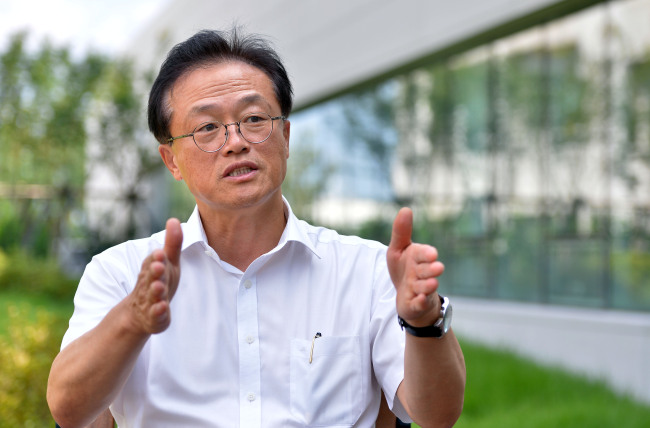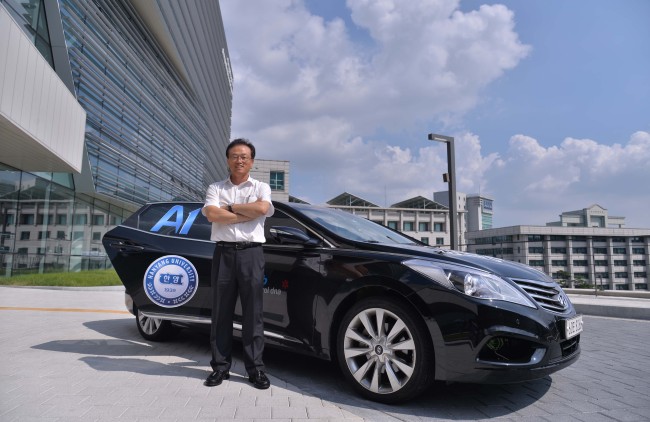Training cars to be smarter
Hanyang University’s Sunwoo Myoungho set to develop control system for future generation vehicles, including self-driving cars
By Yoon Min-sikPublished : Oct. 23, 2015 - 18:20
A black sedan pulls over by the gate next to a group of men. The seemingly insignificant sight edges over to the realm of science fiction when the door opens to reveal no one sitting in the car, not even the driver.
The car turns out to be a fourth-generation prototype of a self-driving vehicle developed by the Automotive Control and Electronics Laboratory at Hanyang University. Yet at first glance, it looks just like any other vehicle roaming the streets of Seoul, with no bulky devices hauled on top.
“The operating system and the computers make no difference in terms of the car’s driving capacity,” explained Sunwoo Myoungho, an expert in automotive systems engineering and director of the ACE Lab.
The car turns out to be a fourth-generation prototype of a self-driving vehicle developed by the Automotive Control and Electronics Laboratory at Hanyang University. Yet at first glance, it looks just like any other vehicle roaming the streets of Seoul, with no bulky devices hauled on top.
“The operating system and the computers make no difference in terms of the car’s driving capacity,” explained Sunwoo Myoungho, an expert in automotive systems engineering and director of the ACE Lab.

Self-driving car, also referred to as an autonomous car, is a vehicle that is capable of fulfilling the transport needs with little to no human input. It is one of the two pillars of ACE Lab’s main field of research in next-generation cars.
“We have two research groups; for the “green” car and “smart” car,” said Sunwoo, referring to environmentally-friendly vehicles like hybrid and electric cars and vehicles that can operate on their own.
Sunwoo has worked as a professor of automotive engineering at Hanyang University since 1993. He was a formerly a researcher for the General Electronics and used to head the Korea Society of Automotive Engineers.
His Ace Lab has performed a variety of research projects with local and international companies and research facilities, including Motorola, Hyundai-Kia Motors, Hyundai MOBIS and Center for Environmental Research and Technology at University of California-Riverside,
He said that the focal point of self-driving cars is safety.
“Each year, around 1.3 million people die from traffic-related accidents while 50 million more get hurt. Some 90 percent of them are due to human error,” Sunwoo said. “If we were to make cars smarter, we can evade the situation as a whole.”
Autonomous vehicles use a series of sensors to perceive the situation around them, evaluate and take the most appropriate actions. This includes the global positioning system, cameras installed on all sides of the car, radar and lidar ― which uses laser to measure the distance by analyzing the reflected light.
The software analyzes the data input to decide which action to take, including changing lanes, evading obstacles, or changing the route to final destination. Naturally, the process requires a combination of several state-of-the-art technologies.
Sunwoo said his Ace Lab team takes great pride in the control system, but is seeking cooperation with international companies like semiconductor manufacturer Infineon Technologies, or Valeo, one of the leaders in automatic parking system.
Many of the commercialized cars already have automated features such as electronic stability control, automatic braking and adaptive cruise control system, but autonomous car take it to the next level.
Autonomous cars are categorized according to the level of human input they require for operation. Level 0 refers to regular cars that the driver has to control the whole time, while vehicles with some of the automated features are called level 1.
Level 2 is when the at least two controls can be simultaneously operated, while level 3 is when the driver can fully relinquish control of all critical functions in certain conditions. Level 4 refers to those that can provide a completely-driverless trip.
“I’d say right now we are at about level 2.5, trying to get to level 3,” Sunwoo said.

Although the ACE Lab’s sedan appears to be performing fine, there are a myriad of obstacles remaining on the path to commercialization.
“First, we have to ‘train’ (the cars). There are roughly 300,000 traffic signs around the world, and we have to figure out a way to make the car recognize all of them. In Korea alone, there are signs of all shapes and size, depending on which region you are in,” Sunwoo said. “In that sense, I’d say regular roads are tougher for automated cars than freeways.
Legislative limits also hinder driverless cars, he pointed out. Korea’s traffic law stipulates that all cars must have a driver, which prevents test-driving on the road.
In the U.S., the leader in research for self-driving cars, the states of Nevada, Florida, California, Michigan, Virginia along with Washington D.C. have passed laws permitting autonomous cars to be tested on public roads.
“We can only test the autonomous cars in limited areas designated by the government, which presents limits. The government is too concerned about the liability issues in case of accidents,” Sunwoo said.
Other obstacles for developing autonomous vehicles include the fact that many of the parts are imported and researchers face limited resources.
“In terms of autonomous cars, the U.S. started research in 1986. Google for example uses around 600 to 700 million won ($530,000-$620,000) per car, while we can only use around 200 million won,” he said.
Government support is also crucial for the electric car industry which Sunwoo, the head of the Electric Vehicle Association of Asia Pacific, has emphasized.
“There are several reasons that Koreans have shown little interest in electric cars, most important being the lack of interest shown by the government. Most other countries provide plenty of subsidy for people buying electric cars, but Korea only provides a small amount.
“The second is the lack of infrastructure like charging stations. The governments of leading countries in electric car industry take a much bigger role in building the infrastructure,” he said.
He pointed out that the importance of environment-friendly cars will continue to grow as the world continues to step up the limits on greenhouse gas emissions.
(minsikyoon@heraldcorp.com)







![[KH Explains] Hyundai's full hybrid edge to pay off amid slow transition to pure EVs](http://res.heraldm.com/phpwas/restmb_idxmake.php?idx=644&simg=/content/image/2024/04/18/20240418050645_0.jpg&u=20240419100350)







![[From the Scene] Monks, Buddhists hail return of remains of Buddhas](http://res.heraldm.com/phpwas/restmb_idxmake.php?idx=652&simg=/content/image/2024/04/19/20240419050617_0.jpg&u=20240419175937)

![[KH Explains] Hyundai's full hybrid edge to pay off amid slow transition to pure EVs](http://res.heraldm.com/phpwas/restmb_idxmake.php?idx=652&simg=/content/image/2024/04/18/20240418050645_0.jpg&u=20240419100350)

![[Today’s K-pop] Illit drops debut single remix](http://res.heraldm.com/phpwas/restmb_idxmake.php?idx=642&simg=/content/image/2024/04/19/20240419050612_0.jpg&u=)